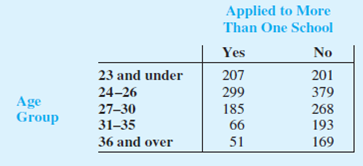
Essentials Of Statistics For Business & Economics
9th Edition
ISBN: 9780357045435
Author: David R. Anderson, Dennis J. Sweeney, Thomas A. Williams, Jeffrey D. Camm, James J. Cochran
Publisher: South-Western College Pub
expand_more
expand_more
format_list_bulleted
Concept explainers
Textbook Question
Chapter 4, Problem 52SE
An MBA new-matriculants survey provided the following data for 2018 students.

- a. For a randomly selected MBA student, prepare a joint
probability table for the experiment consisting of observing the student’s age and whether the student applied to one or more schools. - b. What is the probability that a randomly selected applicant is 23 or under?
- c. What is the probability that a randomly selected applicant is older than 26?
- d. What is the probability that a randomly selected applicant applied to more than one school?
Expert Solution & Answer
Want to see the full answer?
Check out a sample textbook solution
Chapter 4 Solutions
Essentials Of Statistics For Business & Economics
Ch. 4.1 - 1. An experiment has three steps with three...Ch. 4.1 - 2. How many ways can three items be selected from...Ch. 4.1 - How many permutations of three items can be...Ch. 4.1 - 4. Consider the experiment of tossing a coin three...Ch. 4.1 - 5. Suppose an experiment has five equally likely...Ch. 4.1 - An experiment with three outcomes has been...Ch. 4.1 - A decision maker subjectively assigned the...Ch. 4.1 - In the city of Milford, applications for zoning...Ch. 4.1 - Simple random sampling uses a sample of size n...Ch. 4.1 - Code Churn. Code Churn is a common metric used to...
Ch. 4.1 - Tri-State Smokers. A Gallup Poll of U.S. adults...Ch. 4.1 - A company that manufactures toothpaste is studying...Ch. 4.1 - Powerball Lottery. The Powerball lottery is played...Ch. 4.2 - An experiment has four equally likely outcomes:...Ch. 4.2 - 15. Consider the experiment of selecting a playing...Ch. 4.2 - Consider the experiment of rolling a pair of dice....Ch. 4.2 - Refer to the KPL sample points and sample point...Ch. 4.2 - 18. Fortune magazine publishes an annual list of...Ch. 4.2 - 19. Do you think global warming will have an...Ch. 4.2 - Junior Achievement USA and the Allstate Foundation...Ch. 4.2 - Fatal Collisions with a Fixed Object. The National...Ch. 4.3 - Suppose that we have a sample space with five...Ch. 4.3 - 23. Suppose that we have a sample space S = {E1,...Ch. 4.3 - Clarkson University surveyed alumni to learn more...Ch. 4.3 - Americans Using Facebook and LinkedIn. A 2018 Pew...Ch. 4.3 - 26. Information about mutual funds provided by...Ch. 4.3 - Social Media Use. A marketing firm would like to...Ch. 4.3 - A survey of magazine subscribers showed that 45.8%...Ch. 4.3 - High school seniors with strong academic records...Ch. 4.4 - 30. Suppose that we have two events, A and B, with...Ch. 4.4 - 31. Assume that we have two events, A and B, that...Ch. 4.4 - Living with Family. Consider the following example...Ch. 4.4 - 33. Students taking the Graduate Management...Ch. 4.4 - The bureau of Transportation Statistics reports...Ch. 4.4 - 35. To better understand how husbands and wives...Ch. 4.4 - Jamal Crawford of the National Basketball...Ch. 4.4 - Giving Up Electronics. A 2018 Pew Research Center...Ch. 4.4 - The Institute for Higher Education Policy, a...Ch. 4.5 - The prior probabilities for events A1 and A2 are...Ch. 4.5 - 40. The prior probabilities for events A1, A2, and...Ch. 4.5 - 41. A consulting firm submitted a bid for a large...Ch. 4.5 - A local bank reviewed its credit card policy with...Ch. 4.5 - Prostate Cancer Screening. According to a 2018...Ch. 4.5 - ParFore created a website to market golf equipment...Ch. 4.5 - Americans Without Health Insurance. The National...Ch. 4 - A survey of adults aged 18 and older conducted by...Ch. 4 - 47. A financial manager made two new...Ch. 4 - 48. Forty-three percent of Americans use social...Ch. 4 - A study of 31,000 hospital admissions in New York...Ch. 4 - 50. A telephone survey to determine viewer...Ch. 4 - The U.S. Census Bureau serves as the leading...Ch. 4 - An MBA new-matriculants survey provided the...Ch. 4 - 53. Refer again to the data from the MBA...Ch. 4 - 54. In February 2012, the Pew Internet & American...Ch. 4 - 55. A large consumer goods company ran a...Ch. 4 - 56. Cooper Realty is a small real estate company...Ch. 4 - A company studied the number of lost-time...Ch. 4 - According to the Open Doors Report, 9.5% of all...Ch. 4 - An oil company purchased an option on land in...Ch. 4 - The five most common words appearing in spam...Ch. 4 - Robs Market (RM) is a regional food store chain in...
Knowledge Booster
Learn more about
Need a deep-dive on the concept behind this application? Look no further. Learn more about this topic, statistics and related others by exploring similar questions and additional content below.Recommended textbooks for you

Mod-01 Lec-01 Discrete probability distributions (Part 1); Author: nptelhrd;https://www.youtube.com/watch?v=6x1pL9Yov1k;License: Standard YouTube License, CC-BY
Discrete Probability Distributions; Author: Learn Something;https://www.youtube.com/watch?v=m9U4UelWLFs;License: Standard YouTube License, CC-BY
Probability Distribution Functions (PMF, PDF, CDF); Author: zedstatistics;https://www.youtube.com/watch?v=YXLVjCKVP7U;License: Standard YouTube License, CC-BY
Discrete Distributions: Binomial, Poisson and Hypergeometric | Statistics for Data Science; Author: Dr. Bharatendra Rai;https://www.youtube.com/watch?v=lHhyy4JMigg;License: Standard Youtube License